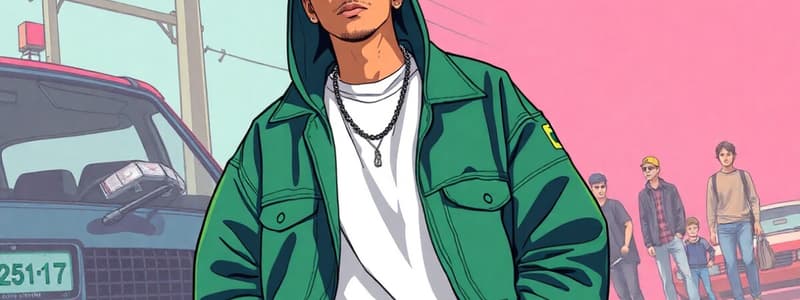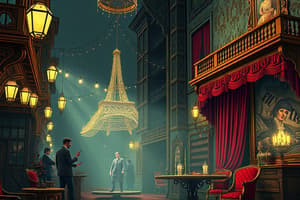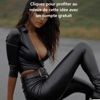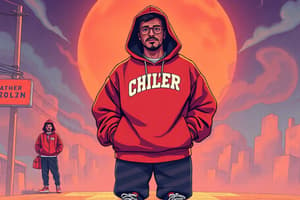Podcast
Questions and Answers
Which factor did NOT significantly contribute to the mainstream rise of streetwear in the 1990s?
Which factor did NOT significantly contribute to the mainstream rise of streetwear in the 1990s?
- Increased visibility through music videos and celebrity endorsements.
- The growing influence of youth culture on fashion trends.
- The fusion of streetwear with high fashion elements.
- Limited availability and high pricing of streetwear items. (correct)
How did the grunge movement primarily influence fashion in the 1990s?
How did the grunge movement primarily influence fashion in the 1990s?
- By emphasizing luxury materials and high-end designer brands.
- By popularizing DIY fashion and deconstructed styles that challenged mainstream norms. (correct)
- By promoting a return to polished and refined aesthetics.
- By reinforcing the fashion industry's traditional, hierarchical structures.
What is a defining characteristic of minimalist fashion as it emerged in the 1990s?
What is a defining characteristic of minimalist fashion as it emerged in the 1990s?
- Bold patterns and vibrant color palettes.
- Embellishments and intricate detailing.
- Clean lines, simple silhouettes, and neutral color palettes. (correct)
- Deconstructed garments and avant-garde designs.
Which designer is best known for avant-garde designs, including deconstructed garments and conceptual presentations?
Which designer is best known for avant-garde designs, including deconstructed garments and conceptual presentations?
How did the fusion of streetwear and high fashion impact the fashion industry's traditional power dynamics?
How did the fusion of streetwear and high fashion impact the fashion industry's traditional power dynamics?
Which of the following is the MOST accurate description of how established designers responded to the fashion shifts of the 1990s?
Which of the following is the MOST accurate description of how established designers responded to the fashion shifts of the 1990s?
What aspect of the grunge movement contributed MOST to its appeal and widespread adoption in the early 1990s?
What aspect of the grunge movement contributed MOST to its appeal and widespread adoption in the early 1990s?
Which garment is MOST representative of the minimalist aesthetic that gained traction in the 1990s?
Which garment is MOST representative of the minimalist aesthetic that gained traction in the 1990s?
Which of the following best describes Alexander McQueen's contribution to the fashion industry during the 1990s?
Which of the following best describes Alexander McQueen's contribution to the fashion industry during the 1990s?
What broader cultural shift is reflected by luxury brands collaborating with streetwear labels?
What broader cultural shift is reflected by luxury brands collaborating with streetwear labels?
Flashcards
Streetwear Origins
Streetwear Origins
Emerged from hip-hop, skateboarding, and punk rock in the late 1970s and early 1980s. Comfortable, functional clothing such as t-shirts and hoodies.
Streetwear's Rise Factors
Streetwear's Rise Factors
Increased media visibility, youth culture influence, accessibility, and fusion with high fashion elements contributed to its rise.
Grunge Fashion
Grunge Fashion
Rejected mainstream norms, embracing individuality. Included distressed denim and oversized flannel shirts.
Minimalism in Fashion
Minimalism in Fashion
Signup and view all the flashcards
Key Minimalist Designers
Key Minimalist Designers
Signup and view all the flashcards
Designer Adaptations
Designer Adaptations
Signup and view all the flashcards
Martin Margiela's Style
Martin Margiela's Style
Signup and view all the flashcards
Alexander McQueen's Style
Alexander McQueen's Style
Signup and view all the flashcards
High-Low Fashion Fusion
High-Low Fashion Fusion
Signup and view all the flashcards
1990s Fashion Legacy
1990s Fashion Legacy
Signup and view all the flashcards
Study Notes
- Fashion in the 1990s experienced a shift away from the opulence and excess of the 1980s
- The decade embraced minimalism, grunge, and the rise of streetwear, influencing both high fashion and mainstream trends
- Simultaneously, established designers adapted to changing tastes, while new talents emerged, shaping the industry's direction
Streetwear Origins and Rise
- Streetwear emerged from subcultures like hip-hop, skateboarding, and punk rock in the late 1970s and early 1980s
- It initially consisted of comfortable, functional clothing such as t-shirts, hoodies, sneakers, and baseball caps
- These items were often branded with logos of sports teams, music groups, or emerging streetwear labels
- The adoption of streetwear by youth subcultures facilitated its spread from local scenes to a global audience
- The 1990s saw streetwear gain significant momentum, transitioning from niche market to mainstream fashion
- Factors contributing to this rise included:
- Increased media visibility through music videos and celebrity endorsements
- The growing influence of youth culture on fashion trends
- The accessibility and affordability of streetwear items
- The fusion of streetwear with high fashion elements
- Key streetwear brands of the era include Stüssy, Supreme, and others, which established themselves as influential players, setting trends and shaping the aesthetic of the movement
Grunge Influence
- Grunge emerged in the early 1990s from the Seattle music scene
- It was characterized by a rejection of mainstream fashion norms and an embrace of individuality and authenticity
- Grunge fashion featured:
- Distressed denim
- Oversized flannel shirts
- Band tees
- Combat boots
- A general disheveled appearance
- The anti-establishment ethos of grunge resonated with many young people who felt alienated by the materialism of the 1980s
- Designers like Marc Jacobs incorporated grunge elements into their collections, further popularizing the trend
- This fusion of high fashion and subcultural style influenced the broader fashion landscape, blurring the lines between luxury and street style
Minimalism
- Minimalism emerged as a reaction against the extravagance of the 1980s
- It emphasized clean lines, simple silhouettes, and neutral color palettes
- Key elements of minimalist fashion included:
- Streamlined dresses
- Tailored pantsuits
- Slip dresses
- Cashmere sweaters
- Unadorned accessories
- Minimalist designers such as:
- Jil Sander
- Calvin Klein
- Helmut Lang
- These designers gained prominence for their understated yet sophisticated designs
- Their collections offered a refined alternative to the more flamboyant trends of the past
- Minimalism became associated with a sense of sophistication, intellectualism, and understated luxury
Designer Adaptations and Innovations
- Established designers adapted to the changing fashion landscape of the 1990s by incorporating elements of streetwear, grunge, and minimalism into their collections
- Karl Lagerfeld at Chanel, for example, experimented with deconstructed silhouettes and more casual fabrics
- New designers emerged, challenging traditional fashion norms and pushing the boundaries of creativity
- Martin Margiela gained recognition for his avant-garde designs, including deconstructed garments and conceptual presentations
- Alexander McQueen, known for his theatrical runway shows and darkly romantic aesthetic, also rose to prominence during this period
- These designers brought fresh perspectives and innovative techniques to the industry, contributing to its dynamism and evolution
Impact on High Fashion
- The rise of streetwear and the influence of subcultural styles had a significant impact on high fashion
- Luxury brands began to collaborate with streetwear labels and incorporate streetwear elements into their collections
- This fusion of high and low fashion reflected a broader cultural shift towards inclusivity and democratization
- The traditional hierarchies of the fashion industry were challenged as street style and youth culture gained greater recognition and influence
- The 1990s paved the way for a more diverse and dynamic fashion landscape, where creativity and individuality were celebrated
- This era laid the groundwork for the continued convergence of streetwear and high fashion in the 21st century
Studying That Suits You
Use AI to generate personalized quizzes and flashcards to suit your learning preferences.





